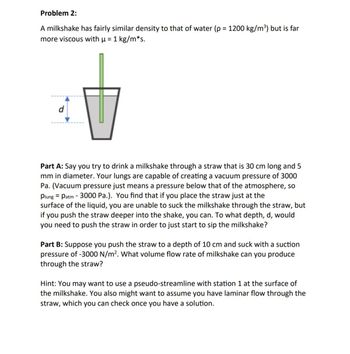
Elements Of Electromagnetics
7th Edition
ISBN: 9780190698614
Author: Sadiku, Matthew N. O.
Publisher: Oxford University Press
expand_more
expand_more
format_list_bulleted
Question
w

Transcribed Image Text:Problem 2:
A milkshake has fairly similar density to that of water (p = 1200 kg/m³) but is far
more viscous with µ = 1 kg/m*s.
d
Part A: Say you try to drink a milkshake through a straw that is 30 cm long and 5
mm in diameter. Your lungs are capable of creating a vacuum pressure of 3000
Pa. (Vacuum pressure just means a pressure below that of the atmosphere, so
plung Patm 3000 Pa.). You find that if you place the straw just at the
-
surface of the liquid, you are unable to suck the milkshake through the straw, but
if you push the straw deeper into the shake, you can. To what depth, d, would
you need to push the straw in order to just start to sip the milkshake?
Part B: Suppose you push the straw to a depth of 10 cm and suck with a suction
pressure of -3000 N/m². What volume flow rate of milkshake can you produce
through the straw?
Hint: You may want to use a pseudo-streamline with station 1 at the surface of
the milkshake. You also might want to assume you have laminar flow through the
straw, which you can check once you have a solution.
Expert Solution
This question has been solved!
Explore an expertly crafted, step-by-step solution for a thorough understanding of key concepts.
Step by stepSolved in 2 steps with 3 images

Knowledge Booster
Similar questions
- Determine the x, y, z components of reaction at the journal bearing C if 0 = 0°.arrow_forwardThe next several problems utilize the same data given in this problem statement. I suggest you glance over the next few problems, so that you have an idea of the items you will need to calculate. You may determine that you calculate the items in an order other than that given on the test (doing this is OK!). BUT, be sure you look at EACH problem and provide the answer to that particular problem. Consider the bracket shown in Fig-3. If: • F1 = 10 lb @ -90° • a = 2 ft • b= 4 ft • C = 1 ft then, what is the magnitude of the vertical reaction at point 'A? O O lb O 10 lb O 14.2 Ib O 20 lb O 26.4 Ib O 30 lb O 32.3 lb O 40 lb O 45 lb O 50 lb O 54.1 Ib O 60 lb O 67.1 Ib O 70 Ib O 72.7 Ibarrow_forwardPls draw the offset sectional view of the solid in the attached image.arrow_forward
arrow_back_ios
arrow_forward_ios
Recommended textbooks for you
 Elements Of ElectromagneticsMechanical EngineeringISBN:9780190698614Author:Sadiku, Matthew N. O.Publisher:Oxford University Press
Elements Of ElectromagneticsMechanical EngineeringISBN:9780190698614Author:Sadiku, Matthew N. O.Publisher:Oxford University Press Mechanics of Materials (10th Edition)Mechanical EngineeringISBN:9780134319650Author:Russell C. HibbelerPublisher:PEARSON
Mechanics of Materials (10th Edition)Mechanical EngineeringISBN:9780134319650Author:Russell C. HibbelerPublisher:PEARSON Thermodynamics: An Engineering ApproachMechanical EngineeringISBN:9781259822674Author:Yunus A. Cengel Dr., Michael A. BolesPublisher:McGraw-Hill Education
Thermodynamics: An Engineering ApproachMechanical EngineeringISBN:9781259822674Author:Yunus A. Cengel Dr., Michael A. BolesPublisher:McGraw-Hill Education Control Systems EngineeringMechanical EngineeringISBN:9781118170519Author:Norman S. NisePublisher:WILEY
Control Systems EngineeringMechanical EngineeringISBN:9781118170519Author:Norman S. NisePublisher:WILEY Mechanics of Materials (MindTap Course List)Mechanical EngineeringISBN:9781337093347Author:Barry J. Goodno, James M. GerePublisher:Cengage Learning
Mechanics of Materials (MindTap Course List)Mechanical EngineeringISBN:9781337093347Author:Barry J. Goodno, James M. GerePublisher:Cengage Learning Engineering Mechanics: StaticsMechanical EngineeringISBN:9781118807330Author:James L. Meriam, L. G. Kraige, J. N. BoltonPublisher:WILEY
Engineering Mechanics: StaticsMechanical EngineeringISBN:9781118807330Author:James L. Meriam, L. G. Kraige, J. N. BoltonPublisher:WILEY

Elements Of Electromagnetics
Mechanical Engineering
ISBN:9780190698614
Author:Sadiku, Matthew N. O.
Publisher:Oxford University Press

Mechanics of Materials (10th Edition)
Mechanical Engineering
ISBN:9780134319650
Author:Russell C. Hibbeler
Publisher:PEARSON

Thermodynamics: An Engineering Approach
Mechanical Engineering
ISBN:9781259822674
Author:Yunus A. Cengel Dr., Michael A. Boles
Publisher:McGraw-Hill Education

Control Systems Engineering
Mechanical Engineering
ISBN:9781118170519
Author:Norman S. Nise
Publisher:WILEY

Mechanics of Materials (MindTap Course List)
Mechanical Engineering
ISBN:9781337093347
Author:Barry J. Goodno, James M. Gere
Publisher:Cengage Learning

Engineering Mechanics: Statics
Mechanical Engineering
ISBN:9781118807330
Author:James L. Meriam, L. G. Kraige, J. N. Bolton
Publisher:WILEY